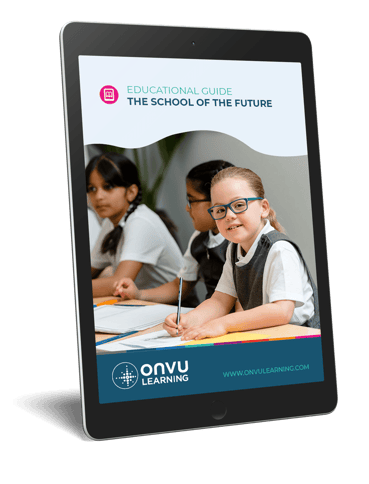- Self-Reflection
- 5 Minute Read



Trainee teachers are used to reflecting on their classroom experience, although this is usually focused on particular issues. As the challenges of a full teaching timetable take their toll, the majority of teachers stop reflecting in the dash for the next lesson. And for others, reflection can become a negative process where the teacher identifies problems with a lesson or class (or is told about them in a lesson observation) but does not have the time or support to analyse the issues and come up with solutions.
However, there is clear evidence that reflection is a powerful tool that is at the heart of improving teaching and learning when teachers have both the time and tools to “professionally notice” the important things in their classroom and reflect on them – by themselves, through dialogue with colleagues or expert coaches.
One experienced teacher summed up this experience when she wrote on Twitter,
‘Teachers have to stop being pulled a thousand different ways and be shown once again in thorough and reflective training that they are the experts. They need to develop successful methods that they own’.
There are many benefits cited from teacher self-reflection. These include:
Read Teacher Self Reflection: Unveiling 8 Compelling Benefits for a deeper dive.
At ONVU Learning we’ve also found a number of these happening in practice. For example, Zara Sahota a teacher at Aston University Engineering Academy told us about how she had increased her confidence as a teacher through reflection and subsequent dialogue with another experienced teacher.
She told us: ‘Deliberately setting weekly time aside to look back at what has happened keeps it fresh in my mind. This makes me think about approaching things differently as I go into other lessons. The impact of this is that when ‘in the moment’ I think, is there a different way?”
You can read about these benefits in the Cambridge International Assessment and Reflective Teaching Journal.
‘deliberately setting weekly time aside to look back at what has happened keeps it fresh in my mind. This makes me think about approaching things differently as I go into other lessons. The impact of this is that when ‘in the moment’ I think, is there a different way?”
Here are 8 steps for a workload-friendly and sustainable approach to reflection:
It’s important to start small. It’s going to be difficult to focus on more than one teaching group and their issues, so it might be more beneficial to zoom in even closer and look at a small group or even a single individual you’re concerned about. Your issue might be something you’re concerned about – examples might include behaviour management, explaining new ideas, questioning, or effective group work. This Hereford Academy case study shows an NQT focusing on specific issues with one year 9 class.
Reflection works best when you can spend time doing it close to the lesson you’re thinking about – so try to find a lesson before lunchtime, at the end of the day or when you have free time.
The problem with the focus on graded or ‘tick box’ lesson observations means that many teachers can approach reflection as a process for demonstrating how ‘good’ they are. It’s important to frame reflection as an objective approach – all teachers will do many things well but be able to identify areas to become even better at.
Write down your impressions of the lesson as soon as possible. It might seem difficult to do this, in a lesson but one idea to help is to draw a timeline of the lesson on a blank sheet of paper. You can jot words against specific times as the lesson progresses and then go back and expand your thoughts once the lesson is over. It can help to have students work in front of you when reflecting after the lesson so you can see how they responded to the teaching.
Rather than critiquing your teaching, focus your review on the learning that took place. Were students able to carry out the tasks you set the way you wanted them to? Were there obvious misconceptions in their learning? Did they ask and answer questions in the way you would have expected?
Rather than thinking about doing things ‘better’, focus on what changes you could make that might affect student learning. For example, in this case study from Aston University Engineering Academy, teacher Zara Sahota considered different ways of enabling students to let her know when they understood (or did not understand) new ideas.
At this stage, it is often a good idea to discuss your findings with a colleague or mentor. As our previous blog on ‘lesson study’ pointed out, discussing teaching and learning in an autonomous way can motivate and re-energise teachers. Colleagues can draw on their personal experiences and also suggest ways of implementing and assessing changes you make.
Effective teaching goes beyond self-reflection, as research highlights the necessity of active practice and evaluation for improvement. Self-reflection is an ongoing process – so make sure you apply your new ideas and see their impact. Ensure that you give them time to have an impact and be honest about the changes made as a result. This approach ensures continuous development through practical application and feedback.
Self-reflection is a powerful tool for individual teachers. Sharing with a colleague allows you a chance to work through your ideas and learn from each other, increasing the impact further. But what if your whole school was reflecting and learning together? You get a true learning community and huge impacts on learning. Here are 6 tips to ensure that happens in your school.
Perhaps the most difficult task in embedding self-reflection will be to persuade those in charge of your school of the benefits. If you’re not a senior leader yourself take time to explain both the benefits and the simplicity of the process to the person responsible for staff development. It’s perhaps best to ask for permission to set up a pilot programme, which in itself can be part of your own professional development.
Following on from step one, it’s best to set up a pilot programme and grow a reflection team slowly at first, rather than seeking to make it compulsory for all. That’s of course unless you’re a new school that recruits people committed to the process (as at least one of our partner schools has done). Make sure that new members are all happy with the same methodology and committed to a reflection process that is both constructive and two-way.
Reflection on lessons isn’t new, as our blog on lesson study showed. But this model, bringing three teachers together in a ‘learning triad’ to plan, teach and observe, also lends itself well to self-reflection. Other schools we work with have focused on using self-reflection within departmental or phase teams, with trainee and newly qualified staff, or to deliver a specific subject across a primary school.
More and more schools and trusts are introducing opportunities for teachers to share their development journey through more open and inclusive INSET days, regular training sessions and even their own research journals! Using classroom video lesson observation systems is a great way of doing this!
Whenever something new is introduced to a school it often fails because teachers can’t access the support they need, and the individual (often an external consultant) isn’t around to provide ongoing support. By creating Champions from across the school (ideally across different phases or departments), everyone can access support. Champions can also model self-reflection and share their experiences with their teams.
Schools that have a lot of experience of reflection also see a major change in how they do professional development. Rather than bringing in external ideas or having a short introduction to a new idea at the start of term, teachers find that CPD is focused on more regular, team-based reflection, where new ideas are shared, tried out and evaluated. Some of our partner schools have developed this further and bring in external experts at this stage – to support individuals who are facing specific challenges.
The result of this process? A focused, learning school that moves forward!

The School of the Future Guide is aimed at helping school leaders and teachers make informed choices when designing the learning environments of the future using existing and upcoming technologies, as they seek to prepare children for the rest of the 21st century – the result is a more efficient and competitive school.
KEEP IN TOUCH WITH ONVU LEARNING AND RECEIVE THE LATEST NEWS ON EDTECH, LESSON OBSERVATION, AND TEACHER TRAINING AND DEVELOPMENT.